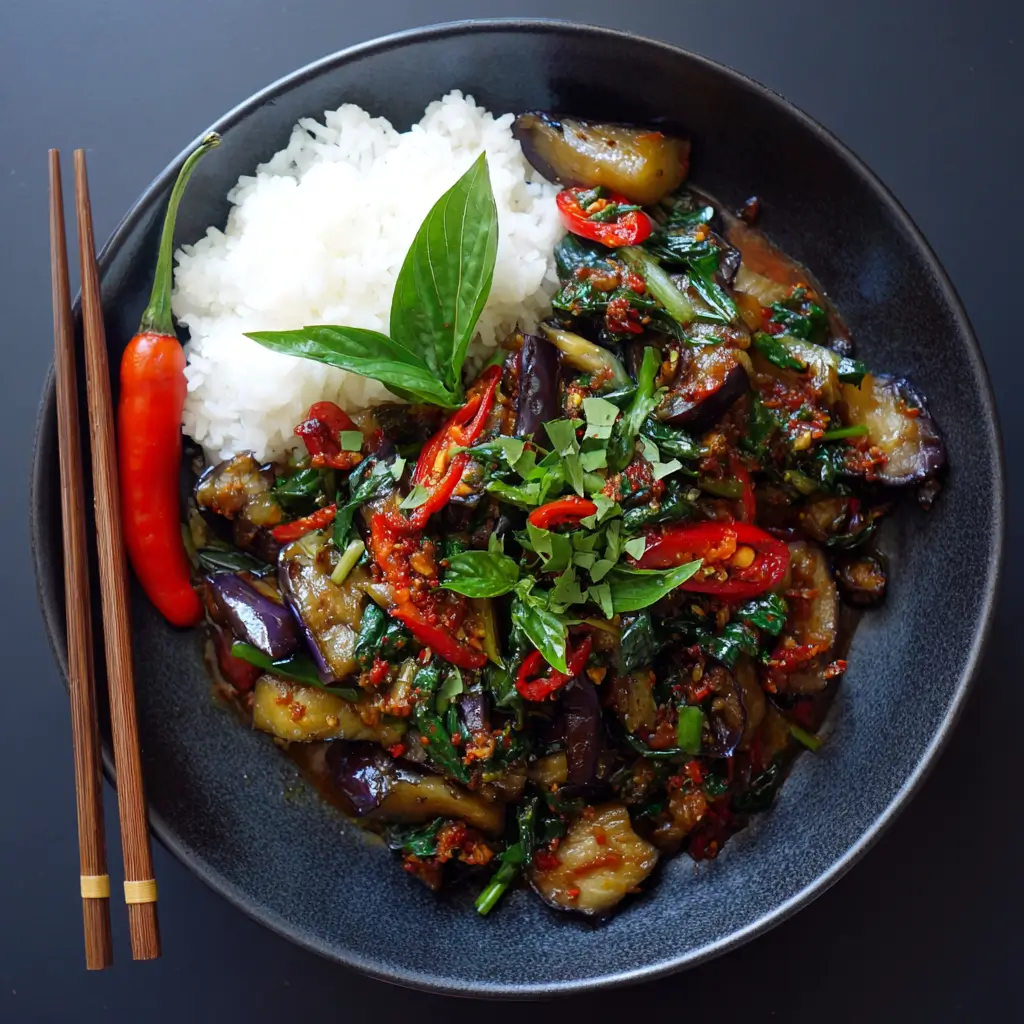Spicy Thai Basil Eggplant Stir Fry: A Flavorful Journey Through Thai Cuisine
The History of Spicy Thai Basil Eggplant Stir Fry
Spicy Thai Basil Eggplant Stir Fry, known in Thailand as Pad Kra Pao Makhuea Yao, is a beloved dish deeply rooted in the culinary traditions of central and southern Thailand. While its exact origins are difficult to pinpoint, stir-fried dishes using holy basil (ka-prao) have long been staples in Thai households due to their aromatic depth and medicinal properties. Historically, this dish evolved from humble beginnings as a quick meal for farmers and laborers who used readily available ingredients like eggplant, chilies, garlic, and fermented fish sauce. Over time, it gained popularity across all social classes and became a favorite street food item, often served with a fried egg on top and accompanied by steamed jasmine rice.
Holy basil, the key herb in this dish, has been used in Thai medicine for centuries to treat respiratory ailments, inflammation, and digestive issues. Its peppery, clove-like flavor distinguishes it from sweet or Thai basil, making it essential for authentic versions of this stir fry. As Thai cuisine gained international acclaim in the late 20th century, variations of this spicy stir fry found their way onto menus worldwide, adapted to local palates while striving to maintain the balance of salty, sweet, sour, and spicy that defines Thai cooking.
Ingredients Breakdown: The Heart of Authentic Flavor
The magic of Spicy Thai Basil Egg-eggplant Stir Fry lies in its harmonious blend of fresh, pungent, and umami-rich ingredients. Each component plays a vital role in creating the complex layers of flavor characteristic of Thai cuisine.
- Eggplants (Long Thai Eggplants or Chinese Eggplants): These slender, purple-skinned varieties are preferred for their tender flesh and mild bitterness, which absorb the bold flavors of the sauce without turning mushy. They are typically sliced into thin ovals or halved lengthwise.
- Holy Basil (Kaphrao): This is non-negotiable for authenticity. Holy basil has a sharp, slightly spicy, anise-clove aroma that sets it apart from other basils. It’s added at the end of cooking to preserve its volatile oils and vibrant fragrance.
- Fresh Thai Chilies (Prik Kee Noo): Tiny but mighty, these bird’s eye chilies deliver intense heat. The number used can be adjusted depending on spice tolerance—typically between 3 to 8 chilies, finely chopped.
- Garlic: Minced fresh garlic forms the aromatic base of the stir fry, sautéed first to release its pungency and sweetness.
- Shallots or Red Onion: Adds subtle sweetness and texture. Shallots are traditional, but red onion works well too.
- Protein (Optional): While the vegetarian version shines with eggplant, many Thai cooks add ground pork, chicken, or tofu for extra heartiness. For a vegan option, use crumbled tempeh or textured vegetable protein.
- Oyster Sauce: Provides a rich, savory-sweet umami backbone. Use vegetarian oyster sauce (made from mushrooms) for a vegan version.
- Fish Sauce (Nam Pla): The quintessential seasoning in Thai cooking, contributing saltiness and depth. Substitute with soy sauce or tamari for a vegetarian alternative, though the flavor profile will shift slightly.
- Soy Sauce (Light): Enhances color and adds a touch more saltiness without overpowering the dish.
- Palm Sugar or Brown Sugar: Balances the heat and salt with a gentle caramel-like sweetness. Palm sugar is preferred for its nuanced flavor.
- Cooking Oil (Vegetable, Canola, or Peanut): High smoke point oils are ideal for the high-heat stir-frying method.
- Lime Wedges (for serving): A squeeze of fresh lime juice brightens the dish and cuts through the richness.
- Fried Egg (optional but recommended): Served on top, the runny yolk adds creaminess and completes the classic presentation.
Step-by-Step Recipe: Crafting the Perfect Stir Fry
Follow these detailed steps to recreate an authentic Spicy Thai Basil Eggplant Stir Fry in your own kitchen. Precision and timing are key—Thai stir fries come together quickly!
- Prep All Ingredients: Before turning on the heat, slice the eggplants into ½-inch thick rounds or lengthwise halves. Mince garlic, chop chilies, thinly slice shallots or onions, and measure out sauces. Have holy basil leaves rinsed and ready. If using protein, cook it separately and set aside.
- Heat the Wok or Skillet: Place a wok or large non-stick skillet over high heat until smoking hot. This ensures proper searing and prevents soggy vegetables.
- Sauté Aromatics: Add 2–3 tablespoons of oil, then immediately add minced garlic and chopped chilies. Stir-fry for 15–20 seconds until fragrant but not burnt.
- Add Onions and Eggplant: Toss in the shallots or onions and stir briefly. Add the eggplant slices, spreading them in a single layer if possible. Let them sear for 1–2 minutes before stirring.
- Stir-Fry Until Tender-Crisp: Continue cooking, stirring occasionally, for 4–6 minutes. The eggplant should soften and develop slight char marks but still hold its shape.
- Add Sauces: Pour in 2 tablespoons oyster sauce, 1 tablespoon fish sauce, 1 teaspoon light soy sauce, and 1 teaspoon palm sugar. Stir well to coat the eggplant evenly. Adjust sweetness or saltiness to taste.
- Incorporate Protein (if using): Return cooked ground meat or tofu to the pan and mix thoroughly.
- Add Holy Basil: Tear or roughly chop the holy basil leaves and add them to the wok. Stir vigorously for 30–60 seconds until wilted and fragrant. Do not overcook, as the herb loses its distinctive aroma when exposed to prolonged heat.
- Taste and Adjust: Check for balance—spicy, salty, sweet, and savory. Add a splash of lime juice or a pinch more sugar if needed.
- Serve Immediately: Plate the stir fry over hot steamed jasmine rice. Top with a freshly fried egg (sunny-side up or over-easy) if desired, and garnish with extra holy basil leaves and chili slices.
Expert Tips for Success
- Use High Heat: A blazing hot wok is crucial for achieving the signature “wok hei” (breath of the wok)—a smoky, charred flavor that defines great stir fries.
- Don’t Crowd the Pan: Cook in batches if necessary to avoid steaming the eggplant instead of searing it.
- Fresh Holy Basil Is Essential: Dried or substituted basil won’t deliver the same punch. If unavailable, Thai sweet basil is a distant second, but expect a milder, sweeter result.
- Prep Ahead: Stir fries move fast. Having everything prepped and within reach ensures smooth execution.
- Balance the Flavors: Taste as you go. The ideal dish should make your lips tingle from spice, your tongue dance with umami, and finish with a hint of sweetness.
- Use a Wok: Its curved shape allows for even heat distribution and efficient tossing. A large flat skillet works in a pinch, but you’ll miss some of the dynamic cooking motion.
- Don’t Overcook Eggplant: It should be tender but not mushy. Undercooked eggplant retains a pleasant bite; overcooked turns slimy.
Variations and Customizations
This versatile dish welcomes creativity while respecting its core identity. Here are several popular adaptations:
- Vegetarian/Vegan Version: Omit fish sauce and use mushroom-based vegetarian oyster sauce and soy sauce. Add marinated tofu, tempeh, or seitan for protein.
- Seafood Twist: Replace eggplant with squid, shrimp, or scallops. Reduce cooking time accordingly to prevent overcooking seafood.
- Extra Vegetables: Add bell peppers, green beans, baby corn, or zucchini for added color and nutrition. Just be mindful of varying cooking times.
- Different Proteins: Ground turkey, beef, or chicken work beautifully. Some recipes even use minced duck for a richer flavor.
- Gluten-Free Option: Ensure your oyster sauce and soy sauce are gluten-free (tamari is a good substitute).
- Milder Version: Reduce or remove chilies and increase garlic and shallots for flavor without heat. Serve with extra lime to brighten.
- Low-Sodium Version: Use reduced-sodium fish sauce and oyster sauce, or dilute with water. Increase lime and herbs to compensate for lost flavor depth.
- With Rice Noodles: Turn it into a noodle stir fry by adding soaked rice vermicelli at the end, tossing everything together for a fusion dish.
Health Considerations and Nutritional Value
Spicy Thai Basil Eggplant Stir Fry is not only delicious but also offers several health benefits when prepared mindfully.
Nutritional Highlights:
- Eggplant: Low in calories and rich in fiber, antioxidants (especially nasunin, which protects brain cells), and potassium. It supports heart health and digestion.
- Holy Basil: Contains eugenol, which has anti-inflammatory and antimicrobial properties. It may help regulate blood sugar and reduce stress.
- Chilies: Capsaicin, the compound responsible for heat, boosts metabolism, reduces appetite, and has pain-relieving effects.
- Garlic and Shallots: Support immune function and cardiovascular health thanks to allicin and other sulfur compounds.
- Fish Sauce/Oyster Sauce: While high in sodium, they provide essential amino acids and umami flavor in small quantities.
Considerations:
- Sodium Content: Fish and oyster sauces are high in salt. Those with hypertension should use them sparingly or opt for low-sodium versions.
- Oil Usage: Traditional stir frying uses moderate oil. To reduce fat, use a non-stick pan and limit oil to 1–2 tablespoons.
- Spiciness: May irritate sensitive stomachs or individuals with acid reflux. Adjust chili levels accordingly.
- Portion Control: Best enjoyed with plenty of steamed rice, but those watching carbs can serve it over cauliflower rice or quinoa.
A typical serving (without rice) contains approximately:
- Calories: 180–250 (depending on oil and protein)
- Protein: 8–12g
- Fat: 10–14g
- Carbohydrates: 15–20g
- Fiber: 5–7g
- Sodium: 800–1200mg (adjustable)
Full Ingredient List
- 2 medium long Thai eggplants (or Chinese eggplants), sliced into ½-inch rounds
- 1 cup fresh holy basil leaves (tightly packed)
- 4–6 Thai bird’s eye chilies, finely chopped (adjust to taste)
- 4 cloves garlic, minced
- 1 small shallot or ¼ red onion, thinly sliced
- 2 tbsp neutral oil (peanut, canola, or vegetable)
- 2 tbsp oyster sauce (vegetarian if needed)
- 1 tbsp fish sauce (or soy sauce for vegetarian)
- 1 tsp light soy sauce
- 1 tsp palm sugar or brown sugar
- Optional: ½ cup cooked ground pork, chicken, tofu, or tempeh
- For serving: steamed jasmine rice, lime wedges, fried egg
Detailed Directions
- Prepare all ingredients: Slice eggplants, mince garlic, chop chilies, slice shallots, and measure sauces. Set holy basil aside.
- Heat a wok or large skillet over high heat until very hot. Add oil and swirl to coat.
- Add garlic and chilies; stir-fry for 15 seconds until aromatic.
- Add shallots and stir briefly. Add eggplant slices in a single layer. Let sear undisturbed for 1 minute.
- Stir and continue cooking for 4–6 minutes, stirring occasionally, until eggplant is tender and slightly caramelized.
- If using protein, add it now and mix well.
- Pour in oyster sauce, fish sauce, soy sauce, and sugar. Stir to coat evenly. Cook for 1 minute.
- Add holy basil leaves. Stir vigorously for 30–60 seconds until wilted and fragrant.
- Taste and adjust seasoning—add lime juice for acidity or sugar for balance if needed.
- Immediately serve over hot jasmine rice. Top with a fried egg and extra basil. Serve with lime wedges on the side.
Frequently Asked Questions (FAQ)
Q: Can I use regular basil instead of holy basil?
A: Not ideally. Holy basil has a unique spicy-clove flavor. Sweet or Italian basil will make the dish taste different—more floral and less pungent. Thai sweet basil is a compromise but still not authentic.
Q: Is this dish spicy?
A: Yes, traditionally it is quite spicy due to Thai bird’s eye chilies. You can reduce or omit chilies for a milder version.
Q: Can I make it ahead of time?
A: Best eaten fresh. Reheating may cause the eggplant to become mushy and the basil to lose its aroma. However, you can prep ingredients in advance for quick cooking later.
Q: What can I substitute for fish sauce?
A: Soy sauce, tamari, or coconut aminos can replace fish sauce, but they lack the fermented depth. For closer flavor, mix soy sauce with a dash of Worcestershire (non-vegetarian) or miso paste.
Q: Why is my eggplant soggy?
A: Likely due to low heat or overcrowding the pan. Use high heat, enough oil, and avoid stirring too frequently to allow searing.
Q: Can I freeze leftovers?
A: Not recommended. Eggplant texture deteriorates after freezing. Store in the fridge for up to 2 days and reheat gently.
Q: Is holy basil the same as tulsi?
A: Yes, holy basil (Ocimum sanctum) is also known as tulsi and is used in Ayurvedic medicine. Culinary holy basil in Thailand is the same plant, though flavor may vary slightly by region.
Q: How do I grow holy basil at home?
A: It thrives in warm, sunny climates. Plant in well-drained soil, water regularly, and harvest leaves frequently to encourage growth. Indoors with grow lights also works.
Summary
Spicy Thai Basil Eggplant Stir Fry is a bold, aromatic dish that captures the essence of Thai street food—fiery, fragrant, and deeply satisfying. With tender eggplant, pungent holy basil, and a perfect balance of salty, sweet, and spicy flavors, it’s a celebration of Thailand’s culinary soul.










